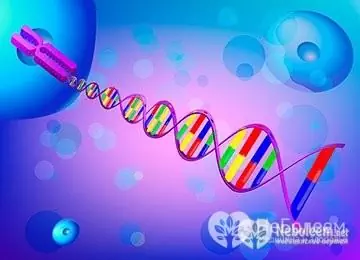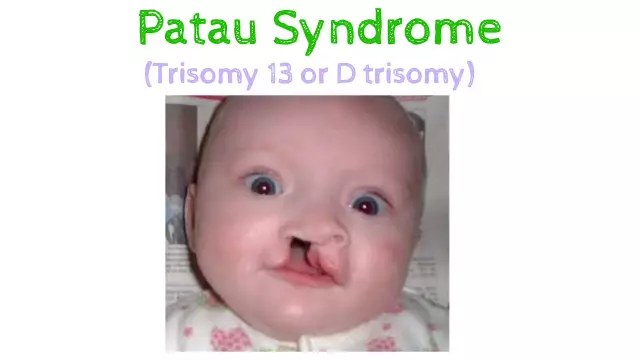- Author Rachel Wainwright [email protected].
- Public 2023-12-15 07:39.
- Last modified 2025-11-02 20:14.
Patau syndrome

Patau syndrome, or trisomy 13 syndrome, is a severe genetic disorder in which there is an extra copy of chromosome 13 in the karyotype (chromosome set).
About 1 in 7,000-10,000 babies are born with this defect. The gene mutation occurs equally in boys and girls.
Causes of Patau syndrome
It has been established that the cause of Patau syndrome, in most cases, is the tripling of chromosome 13, that is, in each cell there are not two (normal), but three copies of the thirteenth chromosome. In very rare cases, only a fraction of the body's cells have an additional copy. This is the so-called Patau mosaic syndrome.
Another cause of the disease is the translocation (rearrangement) of chromosomes, when part of chromosome 13, before or immediately at the time of conception, is attached to another non-homologous chromosome. As a result of such a rearrangement in patients, along with two copies of chromosome 13, additional material appears from it, which is connected to another chromosome. There is a partial trisomy of chromosome 13, in which the physical signs of the syndrome are somewhat different from the typical clinical picture.
As a rule, Patau syndrome is not inherited, but occurs accidentally during the formation of sperm and eggs. If an error occurs during cell division, which is called nondisjunction, this leads to the appearance of germ cells with the wrong number of chromosomes. When such atypical sperm and eggs are drawn into a child's genetic makeup, they receive an extra chromosome 13 in all cells in the body. Mosaicism of this syndrome is also not inherited and arises as an accidental failure during cell division at the initial stage of embryo development.
The disease can be inherited in the case of a balanced translocation, when a healthy person carries altered genetic material between the thirteenth and other chromosomes. Individuals who are carriers are at risk of having children with this genetic disorder, although they themselves do not show signs of trisomy 13.
Clinical picture
All children with Patau syndrome have severe congenital defects of the skull, brain, internal organs and musculoskeletal system.
The characteristic signs of the disease include:
- Inadequately developed bones of the brain and facial skull;
- Trigonocephaly (severe narrowing of the skull in the frontal part and a sharp expansion in the occipital);
- Altered structure of the hands and feet;
- Symmetrical multi-fingers (possible, but not always occurring);
- Narrowing of the eye slits and close location of the eye sockets;
- Shortening of the neck;
- Absence of an iris or an eyeball (sometimes);
- Deformation and improper placement of the auricles;
- Cleft lip and palate;
- Sagging of the nose, etc.
Babies with Patau Syndrome have an underdeveloped digestive system and major brain structures in the central nervous system. Severe malformations are observed in the cardiovascular system - defects in the heart septa and large blood vessels. The genitourinary system suffers: cryptorchidism (undescended testicles), two-horned uterus, hypoplasia of the external genital organs. Sometimes the back wall of the urethra is absent, and the kidneys are greatly enlarged and have cysts in their cortical layer.
Diagnostics of the Patau syndrome
Prenatal diagnosis of all chromosomal diseases, including Patau syndrome, is the same. The first stage of screening includes an ultrasound examination and determination of biochemical markers (PAPP-A, beta-hCG, etc.). Based on the data obtained, the risk of having a child with a genetic disease is calculated.
Pregnant women who are at risk are offered the following invasive prenatal diagnostic methods:
- 8-12 weeks - Chorionic villus sampling (taking a sample of villous cells and checking them for defects);
- 14-18 weeks - amniocentesis (puncture of the amniotic membrane to obtain amniotic fluid for the purpose of their subsequent laboratory examination);
- 20 weeks or more - cordocentesis (analysis of umbilical cord blood).
The obtained materials are searched for trisomy on chromosome 13 by CF-PCR (quantitative fluorescent polymerase chain reaction) or karyotyping with differential chromosome staining.
If prenatal diagnosis of Patau syndrome has not been carried out, the chromosomal abnormality can be identified based on clinical signs. However, to confirm the diagnosis, an analysis is required to determine the chromosome set of the newborn.

Infants with an established or suspected hereditary disease need a thorough comprehensive examination, which is aimed at identifying severe malformations (neurosonography, ultrasound of the kidneys and abdominal organs, echocardiography, etc.).
Treatment and prognosis
There is no specific treatment for Patau syndrome, for obvious reasons (failures in the genetic apparatus). To correct congenital defects, surgical interventions are performed, and to maintain the normal functioning of systems and organs, general strengthening therapy is prescribed (multivitamin complexes, biologically active additives and drugs to increase the level of immunity).
The prognosis for this disease is poor. The bulk of children with Patau syndrome die in the first months of life, only sometimes living up to a year. This is due to the high severity of congenital malformations of internal organs. In rare cases, patients live for 3-5 years, while remaining completely disabled and having severe disorders in psychomotor development.
YouTube video related to the article:
The information is generalized and provided for informational purposes only. At the first sign of illness, see your doctor. Self-medication is hazardous to health!






